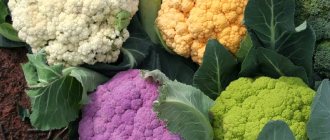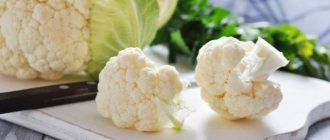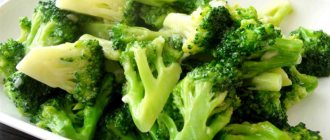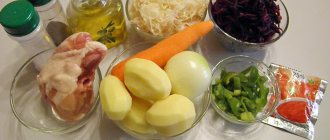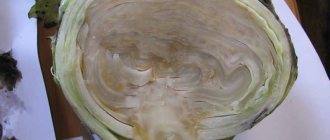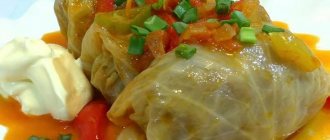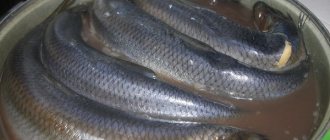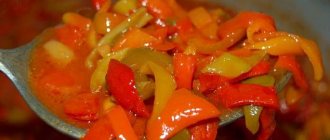Eating cauliflower has a beneficial effect on the body. Therefore, it is a favorite vegetable crop for many people. However, when growing a vegetable yourself, you need to know that the quantity and quality of the harvest are determined not only by the characteristics of cultivation, but also by the principles of harvesting. An important factor is the timing: heads cut ahead of schedule will not be able to reach maximum sizes, and those overexposed in the beds will significantly lose quality and become unsuitable for further storage. Therefore, in this article we will take a closer look at when to harvest cauliflower and how to determine the time for harvesting.
Cauliflower
How to determine cabbage harvest time
Providing proper care for your cauliflower will ensure a successful harvest. Harvesting time depends on the variety of planted crop:
- The formation of inflorescences of early varieties takes two to three months. The harvest is harvested in late June-early July;
- For mid-season varieties, the growing season lasts from 100 to 130 days. Harvesting begins in late July-early August;
- Late-ripening varieties are harvested in late August and early September. The growing season takes 5 months or longer.
REFERENCE: Late-ripening varieties have a long shelf life.
Storing cauliflower
Even under the most favorable conditions, it cannot be stored for more than 60 days. Knowing when to cut cauliflower from the garden, you need to think about its storage. The most common options used by many housewives:
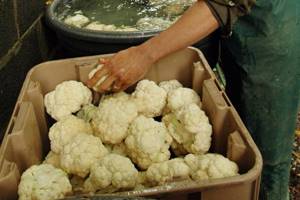
- Placement in a basement with a temperature no higher than 2 degrees and constant humidity around 90%. The ideal container for the inflorescences would be plastic containers, which should be covered with cling film.
- Cauliflower can be stored in the refrigerator without loss of quality characteristics for no more than one month. But to do this, you will have to first wrap the inflorescences with several layers of paper or cling film.
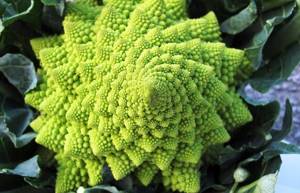
What weather to harvest?
Cauliflower is harvested on a dry and cloudless day. They begin to cut the vegetable at noon, but no longer than seven in the evening.
ATTENTION: It is not recommended to collect cabbage after rain, as this will negatively affect the taste and aroma, as well as keeping quality. This is due to the fact that the crop needs moisture and warmth only during the period of active growth.
If frosts occur and not the entire crop is ripe, the unripe heads are removed along with the root system and earthen clod, and planted in a cool room (greenhouse, cellar). But only on the condition that the head has a radius of at least 2.5 cm and there are about 20 leaves.
How to properly store cauliflower at home, how to choose cauliflower?
- If you purchase cauliflower, take a close look at its density. Fresh vegetables are characterized by excellent density. The head of cabbage is quite heavy , and is covered with white heads of inflorescences.
- spots on the surface of the cauliflower , do not buy it. But, if there are no other heads of cabbage, the spots can be cut off with a knife.
- Pay attention to the cauliflower leaves. They should fit tightly to the head of cabbage and have a rich green tint. Withered leaves indicate that the vegetable has been picked a long time ago and has therefore lost some of its nutrients. There should be no dark spots on the rosettes, as they are a signal that the vegetable is gone.
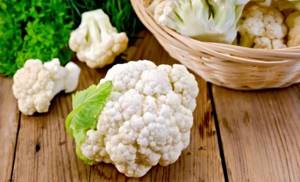
The head of cabbage should be dense and without stains
- After purchasing cauliflower, store the heads in the vegetable drawer of the refrigerator. You can also store vegetables in a plastic bag, which must first be opened. In this state, cauliflower can be stored for no longer than 7 days.
- If you disassemble cauliflower into inflorescences , the shelf life is halved. Fresh inflorescences can be stored in a plastic container for no more than 3 days. Therefore, they need to be cooked immediately after separation.
How to properly cut cauliflower
The cabbage harvest must be carried out not only at the appointed time, but also by adhering to certain rules. This will allow you to preserve the vegetable crop for a long time.
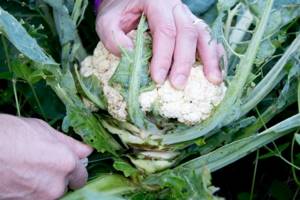
You need to cut according to certain rules.
Existing rules for harvesting cauliflower:
- When the inflorescence reaches a diameter of 20-24 cm, it is fully ripe. Large inflorescences are often not suitable for cooking because they do not retain color and structure;
- Ripe inflorescences must be removed from the plant immediately. Harvest gradually, checking the maturity of the heads every two to three days.
- Cut off the heads with a sharp knife. The lower leaves are also cut off along with the head. Long-term storage can be ensured by removing the cabbage from the soil along with the rhizome;
- The collected vegetables are stored in a cool and dark room. A cut vegetable left in the sun will quickly lose its nutritional value and wither.
HELP: If this is not possible, you need to cover the ripe heads to protect from sunlight
Cauliflower is almost as popular as white cabbage, but the content of some vitamins, minerals and fiber in cauliflower is much higher. Compliance with the basic rules during storage will allow you to preserve the cabbage crop in the winter. Even if cultivation rules are followed, gardeners need to harvest crops in a timely manner with minimal losses.
How to Cook Frozen Cauliflower in a Frying Pan
To make it easy to work with cauliflower after freezing, it is important to store it correctly. To do this, the head of cabbage is cut into individual inflorescences, ready for subsequent heat treatment processes.
In order to make a delicious cauliflower appetizer in batter, frozen inflorescences are dipped in salted boiling water and boiled for 5-6 minutes. After this, the cabbage is drained in a colander.
Place flour in one bowl and beaten egg in another. Each inflorescence is rolled in flour and immersed in a beaten egg, after which it is fried on each side in vegetable oil heated in a frying pan.
To add spiciness to the dish, prepared chilled pieces of cauliflower are coated with mayonnaise with garlic or cheese sauce. You can sprinkle with finely chopped dill, green onions - chives, or other herbs.
Vegetarian Cauliflower Recipes
Cauliflower is a vegetable that deserves special attention. You can use it not only to make healthy baby puree, but also to prepare various light soups and puree soups, summer salads, warm appetizers, stews and casseroles - cauliflower dishes can be very different. The vegetable is delicious baked, boiled, fried, pickled, or even added raw to a dish. Not everyone knows about the last two methods, but pickled cauliflower has a spicy taste and crispy texture. Most often, they prefer to fry it in batter or breadcrumbs - such a snack sells with a bang. The vegetable is wonderful in a duet with an egg and is well suited as a side dish. In addition, in the oven the inflorescences are easily covered with a crispy crust, and the inside of the vegetable remains soft and does not dry out. Cabbage makes delicious, almost dietary, meat casseroles. Recipes with cauliflower are often used by vegetarians and those who fast. They know that in a slow cooker it is easy to prepare a delicious gratin from cauliflower or bake it with fried mushrooms and aromatic cheese. A bouquet of spices plays a big role in preparing white vegetables. Cauliflower itself has a pleasant, but not pronounced taste, so a mixture of salt, garlic, oregano and pepper will only make it brighter.
Dishes based on vegetarian recipes are in no way inferior to meat ones: tasty, satisfying and easy to prepare; they also look beautiful in photos and look stylish on social media feeds. Interestingly, meat-free dishes exist in almost every cuisine in the world, and they are prepared not only during fasting. For example, the famous ratatouille, a traditional Provençal dish of eggplant, zucchini and other seasonal vegetables, is prepared throughout the summer, always with a generous dose of olive oil and herbs such as rosemary, basil and mint. Vegetarian food is worth trying, if only out of curiosity: such an experiment will not only diversify your usual diet, but will also save time: a breakfast of rye toast with avocado, a pinch of Himalayan salt and a poached egg is prepared in five minutes and does not require strict adherence to a step-by-step recipe. A flexible vegetarian nutrition system allows you to include new ingredients in your menu every day: goat and sheep cheese, urbechi, almond milk - with these and many other products, your dishes will have a bright and unusual taste.
Search for recipes by selecting a dish category, subcategory, cuisine or menu. And in additional filters you can search by the desired (or unnecessary) ingredient: just start writing its name and the site will select the appropriate one.
What can you cook from cauliflower?
It is noteworthy that the young vegetable can be consumed raw, although more often it is subjected to heat treatment. Usually the inflorescences are boiled, stewed, or fried. But no matter how you cook, you must first choose the right fruit.
The quality and freshness of cabbage is indicated by the green leaves surrounding the head, which in turn should be dense, heavy and strong. The color of the inflorescences can be varied, but you should focus on an even yellow, snow-white or slightly green color. There should be no dark spots on the head of cabbage, which indicates that it is not fresh.
Having chosen a quality product, the vegetable inflorescences can be cooked and consumed in splendid isolation, or combined with other products and made all sorts of different delicious dishes. Today I will tell you how to properly and tasty fry cauliflower, which can then be baked with sour cream and cheese sauce, poured over eggs and made into scrambled eggs, used as one of the ingredients in a hot salad, pureed and added to meat broth, etc. Well, now, let's move on directly to preparing the food and take a detailed look at the step-by-step recipe.
Ingredients:
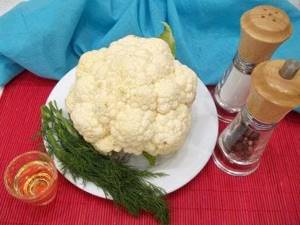
- Cauliflower – 1 head.
- Vegetable oil - for frying.
- Salt and ground black pepper - to taste.
- Any greens - a small bunch.
- Drinking water – 50 ml.
Preparation:
Place the head of cabbage under running water and rinse. Dry with a paper towel and separate into inflorescences.
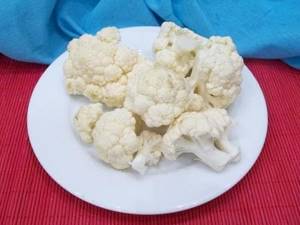
Next, there are two ways to fry a vegetable: first boil it and then fry it, or vice versa - start by frying it and then simmer it. I like the second option better, because... the inflorescences remain more integral. With the first method, they can be overcooked and disintegrate during frying.
So, pour vegetable oil into a frying pan and heat it. Add the inflorescences, set the heat to slightly higher than medium and fry, stirring occasionally until golden brown.
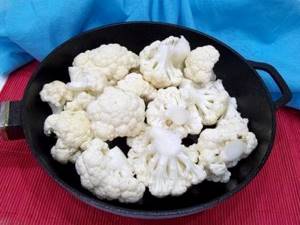
After 15-20 minutes of frying, pour in drinking water (50 ml), boil, reduce the temperature to low, cover the pan with a lid and simmer the inflorescences for another 15 minutes. 5 minutes before readiness, adjust the taste with salt and pepper and bring it to the desired level.
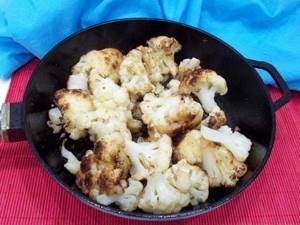
Garnish the delicious fried cauliflower with finely chopped herbs and serve immediately after cooking. Determine the degree of its readiness yourself. If you want the inflorescences to be elastic, remove them from the pan earlier; if you want them to be softer, simmer them longer.
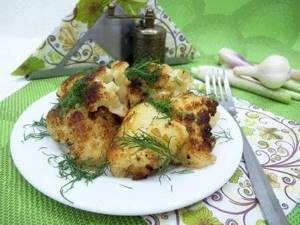
Delicious cauliflower - tips:
- If you boil the cabbage first and then fry it, do not overcook it. It is better to undercook the inflorescences in boiling water than to turn them into an indistinct puree that cannot be fried. Insufficient heat treatment of the vegetable will preserve vitamins and crispiness, because it is tasty even raw. I also advise that after cooking, immediately place it under running cold water, which will prevent further thermal reaction.
- You can also fry cabbage in batter. To do this, you will need to first dip it a little in flour and roll it in beaten egg, and then follow my recipe.
Second harvest of cauliflower: storage and growing
For those who are well acquainted with the agricultural technology of growing cauliflower, they know that fresh and strong heads of cabbage can be delivered to your table until late winter. With those who have recently cultivated this vegetable crop, we are ready to share the secrets of growing and storing cauliflower. After all, your own vegetables from the ground are sweeter and healthier than tasteless “celluloid” products from the supermarket, the prices for which in winter, alas, are not the most affordable.
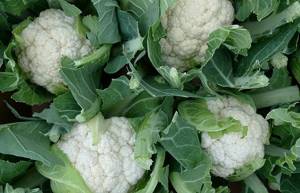
In early varieties of cauliflower grown by seedlings, the first heads are ready for harvest in early June. The snow-white dense inflorescences are removed when they reach a marketable appearance, that is, when they form up to 100 mm in diameter. Since plants, despite being planted at the same time, develop differently, stronger rosettes with powerful foliage have a good chance of producing a second harvest after cutting the head of cabbage.
To do this, you need to remove numerous shoots that form from the axillary buds at the base of the stalk, leaving one or two of the most reliable ones in your opinion. With proper care, timely feeding and watering, the second harvest of cauliflower will be no less generous. True, despite all the favorable forecasts, the weather often makes its own adjustments. A sharp cold snap slows down the growth of the heads; in this case, the plants should be sent for ripening. We will tell you how this is done below.
The beds vacated in early July after harvesting early vegetables can be sown with cauliflower seeds. This is best done from the first to the second decade inclusive. By the beginning of autumn, the plants will gain maximum nutrients, form a powerful crown of leaves and strong, healthy ovaries. Before the onset of frost, all plants - from early varieties that did not have time to form a full-fledged head, as well as from July sowing - should be prepared for winter growing. How it's done?
A couple of days before the moving event, the garden bed is watered abundantly. Choose bushes with a well-developed rosette of leaves (at least 14-16 pieces) and an ovary diameter no smaller than 3 cm. Dig them out carefully, if possible keeping a lump of earth on the roots. To avoid damage to the root system, it is better to wrap it in paper. Planting sites for growing are determined in advance; this can be a basement, greenhouse or greenhouse.
Plants are planted in the recesses quite closely to each other, per 1 square meter. There should be room for at least 30 cauliflower bushes. The roots are sprinkled with soil up to the lower leaves, and the soil is then periodically moistened. One of the important conditions for crop ripening is the absence of light. Greenhouses are insulated with heat and light using available means - straw, leaves and covered with spruce branches. In greenhouses, paper and non-woven fabric are used.
The useful substances accumulated in the leaves of plants during the warm period nourish the formed ovary, due to which it increases 4-5 times to 12-15 cm in diameter. When growing plants in winter, it is very important to observe the temperature regime, since the timing of crop ripening directly depends on this. The natural humidity of the room should be at least 85%.
At t+11-12oC, the growing period for cauliflower is approximately 20 days, at t+5oC - at least one and a half months, and in a cold room at t+1-2oC you can wait for an additional harvest by the end of the third month. Throughout the planting period, check regularly, moistening the soil if necessary and removing dead leaves.
The shelf life of cauliflower after growing can be extended to 3-6 weeks by placing it in a cool, frost-free room (t+1oC) with a humidity level of 80%. Plants are dug up, the roots are cleared of soil and hung on hooks with their heads down. After a month, the cabbage is cleared of leaves and stored wrapped in paper at the same temperature.
As practice shows, proper storage and growing of the crop is a completely reliable way to get an alternative harvest of cauliflower, and with it a lot of useful vitamins for the winter diet. Be healthy!
